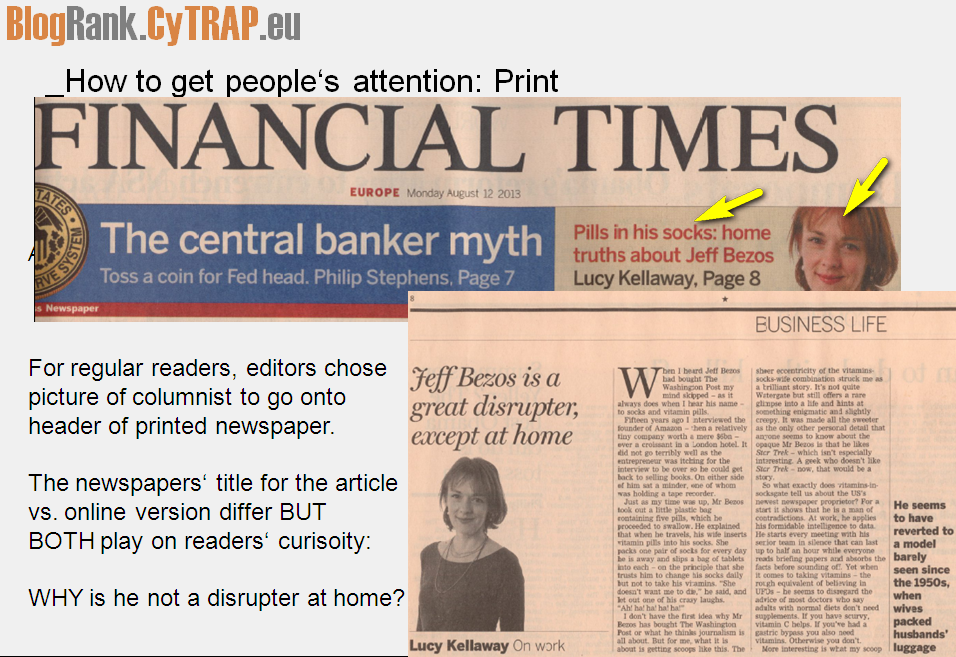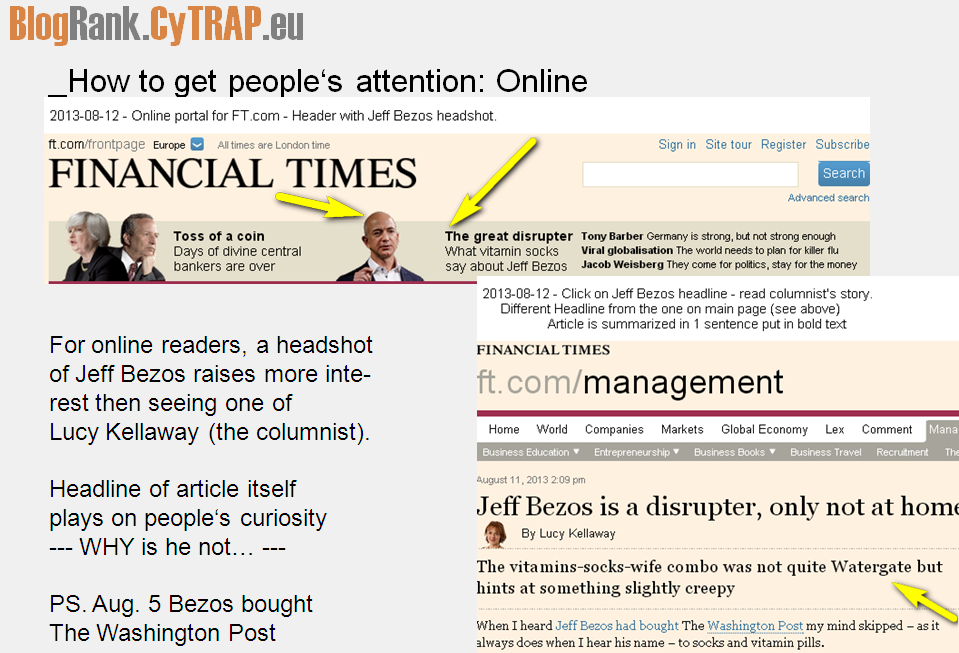How it was: You came up with a story title and that was it.
Today: How Jeff Bezos teaches the staff of The Washington Post to write great story headlines.
 The CyTRAP BlogRank is a measure made up of statistics that help rank blogs. Of particular interest is how blog content is shared with others, and whether these blog entries elicit comments – engagement – from users. Here, headlines play an important role.
The CyTRAP BlogRank is a measure made up of statistics that help rank blogs. Of particular interest is how blog content is shared with others, and whether these blog entries elicit comments – engagement – from users. Here, headlines play an important role.Fiat’s Luis Chilmingras, head of digital innovation and telematics, put it well when he said:
“You can’t reduce [fuel consumption and emissions] if you don’t measure.”
Of course the same applies to blogging and headlines, how good are yours?
By the way, how good is your headline? Check CyTRAP BlogRank – who won?
1. Target audience
Obviously, a headline that uses a well-known brand name, such as Nike or Adidas, fits a sport blog better than it does a banking blog.
Of course, a headline using a term such as drug addiction can raise interest from a few people, and even more when combined:
2. Keep it short and sweet
Besides hitting your target group with a headline that raises their interest, short is usually better.
For instance, Google does not show more than 60 characters in titles when serving search results.
If you can say it in fewer words, such as only 40 characters (letters and spaces), you are likely to get the message across even better.
3. Ubiquitous blogger ‘list’ posts – how to
The ‘how to’ headline is everywhere, online and off, since it works like a charm. An example might be this blog entry’s headline, How to write a great headline.
4. Newsworthy helps
August 5, 2013 saw the purchse of The Washington Post by the founder of Amazon.com, Jeff Bezos. This made the headlines of many newspapers even a week after it happened (see FT example above AND below).
Put simply, the idea is that by playing on a newsworthy item, Lucy Kellaway’s weekly column might pique more people’s interest.
5. Be direct
Jeff Bezos is a disrupter. Such a title is short, newsworthy (brand Jeff Bezos), and most importantly, direct. Direct headlines go straight to the heart of the matter. For example:
- New Social Media Monitoring tool: 30 percent off
The above headline states the selling proposition in a direct way. Another example could be, Get a free web analytics e-book.
6. Raise curiosity
Jeff Bezos is a disrupter, but not at home, is direct, and the second portion (but not at home) raises one’s curiosity.
7. Print is not online
As the above examples from Lucy Kellaway’s column show, the printed newspaper’s front page had a teaser for her column in the header. Interestingly, that was quite different from what the FT chose as a teaser for its online platform (print – Lucy’s headshot, online – Jeff’s headshot). One reason could be that regular readers are likely to check out her column. Online readers might be different and become more interested through a photo of Jeff Bezos. At least this appears to have been FT editors’ reasoning.
Similar to the teaser for the column, its online title was also different than that of the print version. Also, the teaser for the online article plays with buzz words, such as Watergate, creepy, and so forth.
The above illustrates that you can reach many more people with a blog or online news story, but because many are irregular readers or new visitors, it seems the online headline needs to be punchier than the print one.
Do your own test. Most savvy newspaper editors that understand the difference between online and print will respond by adjusting the headlines as the Financial Times did for Lucy Kellaway’s column (e.g., The Guardian, New York Times and Le Monde).
8. Regular reader versus Google search visitor
As pointed out above, your regular readers are more likely to respond to certain things, such as a headshot of yourself (see FT examples above), than those stopping by via Google search results.
By the way, the URL for the blog post should not be the same as your story’s headline (i.e. give more info to potential readers and Google that way).
9. Culture and language – will the why headline work?
Some things might work well in only one culture, country or language, so do not make the mistake of thinking that whatever may work in your country – US, China – works in Luxembourg or Kazakhstan. See also:
Conclusion
“… even though you must try your hardest to get people to read on, you must never assume you’ll succeed,” (Lucy Kellaway). This points out that regardless of how hard we try, sometimes people simply do not read what we write. Or they might read the first 60 words and then move on (see our upcoming post about why first impressions matter).
- By the way, sign up for our blog – it is FREE! Get future news about improvements to our FREE software first.
In autumn, I will report here about the new dashboard that provides a heat map, graphics and much more. Stay tuned, AND register yourself to get your own dashboard for free.
PS. Check out how K.D. Paine’s blog posts with punchy and short headlines get shared more!
What is your experience? What kind of headlines work best for your blog? Please share below.
The author: This post was written by social media marketing and strategy expert Urs E. Gattiker, who also writes about issues that connect social media, strategy, ROI and compliance (click Google Scholar or else Microsoft Scholar), and thrives on the challenge of measuring how it all affects your bottom line.
His latest book, Social Media Audit: Measure for Impact, was recently published by Springer Science Publishers; he is currently working on his next book, scheduled to appear before the end of the year.
Connect with ComMetrics on Google+ or the author using: Email | Twitter | Google+ | Xing



Pingback: Top 50 UK fashion blogs » February March 2014, Who are the top fashion bloggers, criteria do fashion magazines use, How does a fashion brand decide, Keywords, Top 50 US fashion blogs, Top 50 UK fashion blogs you are here, By the way » ComMetrics | me
Pingback: Top 50 US fashion blogs » February March 2014, Who are the top fashion bloggers, criteria do fashion magazines use, How does a fashion brand decide, Keywords, Top 50 US fashion blogs you are here, Top 50 UK fashion blogs, Top 50 Modeblogs in Österreich
Pingback: Top 50: Modeblogs in Österreich » » Dr KPI: ROI, Efficiency, KMU, Kennzahlen, Strategien